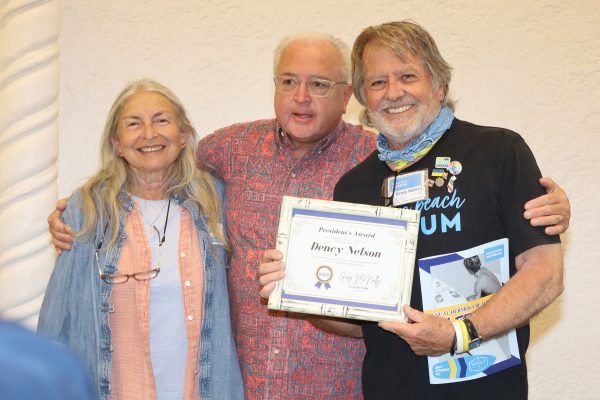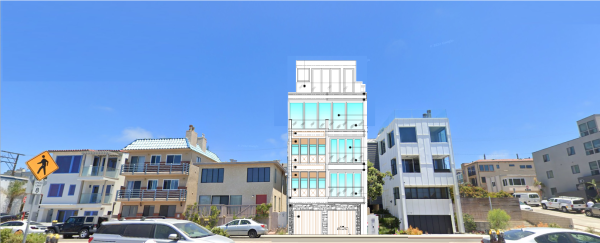I enjoy tasting meals not only for the variety, but because the procession of dishes and the pairing of food and wines test every aspect of an establishment. The chef creates and executes a menu designed like a theatrical production, every effect calculated to build on the previous scene. The sommelier is challenged to pair that changing menu and magnify the intensity of the experience, and the serving staff must deliver both foods and wines with efficiency and style. Restaurants like the French Laundry in Napa and Bastide in Hollywood serve only tasting menus in order to focus on that experience, and a place serving tasting menus while handling the unpredictable demands of regular customers is brave indeed.
It figures that if any restaurant in the South Bay was going to serve tasting menus, it would be Brix. Brix was planned with an outrageous level of ambition, promising to provide both comfort food and exotic cuisine across a wide price range. After a few months in business, they’ve aimed at a more achievable goal: upscale but still affordable food paired with an exceptional selection of wines. After a period of service so attentive that it was intrusive, the place has found its rhythm, and runs like a well-tuned machine. Brix has also instituted chef’s choice tasting menus, the culinary high-wire act where you toss aside the menu completely and have whatever the artist in the kitchen wants to send out.
Our experience started out as all tasting menus should – with our server asking if we had any food allergies or strong dislikes. My companion and I are extremely omnivorous, so we sent word to Chef Michael McDonald that we were ready for anything. Sommelier Caitlin Stansbury came by to ask the same question about beverages, bringing two glasses of Bouillot “Perle d’Aurore” sparkling rosé as she did. We chatted about wine for a moment before she left to confer with the chef about what combinations would arrive at our table. After she left, my companion and I sat back in our overstuffed armchairs to consider our surroundings. There was a pleasant buzz of conversation over music just loud enough for atmosphere. We had probably the worst seating in the house, a cramped table for two where one chair was against a fireplace and the other protruded slightly into a walkway. It was comfortable but would have been better with less awkward furniture – the huge chairs make one feel like a child at the adult’s table.
We were musing about the ergonomics of fine dining when the first dish arrived – tuna tartare chopped and blended with avocado, pine nuts, and a little toasted black sesame, which added creamy, crisp, and nutty textures to the fresh sushi-grade ahi. The wine was a sensible pairing rather than oenological fireworks – it suited the fish nicely and was fine by itself, a light, pleasant start to the meal.
The second dish was less successful but very instructive – a seared diver scallop over braised short ribs, with black truffle shavings on the side. The scallop and meat were both tasty–they would have been fine centerpieces to some light salad or vegetable dish, but the flavors just didn’t have much to do with each other. The truffle worked with the beef, but not the scallop – it was almost as if the scallop was on the plate because the chef had some nice scallops and added them into a more established dish. The wine, a South African Chenin Blanc, was decent with the scallop, but the short rib needed something red and a bit spicier.
There was no such problem with the third course, a fantastic sweet corn ravioli with crispy sweetbreads and fresh sautéed lobster. I had tried the ravioli before and liked them, but the seafood and sweetbreads catapulted this dish into the stratosphere – we were stunned at how well vegetable and seafood sweetness and richness worked with the sweetbreads. We were still more amazed with the wine pairing, since both of us had disliked the Moshin Chardonnay when we first tasted it, and we had thought that the buttery, oaky wine would overwhelm the lobster. It didn’t; the totally different flavors of wine and ravioli were a startling and delightful contrast. With this pairing we realized just how good Stansbury is at her job. She did well at her next challenge, pan seared salmon over lentils with baby bok choy. The dish was the comfort food compared to the exotica we had, but very well executed, the salmon skin crisp and lightly salty, the lentils nutty, the bok choy sweet, and each texture distinct. Stansbury selected a Konrad Pinot Noir from Marlborough, an area better known for crisp Sauvignon Blancs. The wine had a perfect acid balance for seafood, ripe cherry flavors and spice, and I considered stopping by the neighboring wine shop to BUY a bottle on my way home.
The next two dishes explored meaty flavors – a foie gras with fig jam, arugula, and duck prosciutto, and Kobe beef with mashed potato and spinach. The first was interesting but flawed – the foie with fig was delicious, but the duck and arugula seemed like an afterthought. Both were good by themselves, but didn’t make a coherent statement. The Rioja served with it was a sensible counterpart; the Sauterne that is traditional with foie would have been fighting the fig sweetness and would have been wrong with the duck. We were happier with the comfort food of the steak, potatoes, and spinach, simple in concept but expertly done. Kobe steak is often rich but flavorless, but this had a delicate grill flavor and was luscious but not overwhelming. The Shafer Merlot was just the steak wine to match it, hearty and satisfying.
We continued with a well-assorted cheese plate and then desserts: a Valhrona chocolate parfait with fleur de sel and apricot, followed by homemade sorbet. I only got one taste of the parfait due to the only service misstep of the evening – I briefly walked to a neighboring table to talk to a friend, and an ever-attentive server assumed I was done and whisked it away. He apologized and offered to bring another one, but though the flavor was excellent I was rather full and decided to have one the next time I visited. By then the homemade sorbet was arriving along with excellent plum-infused sparkling sake, and I decided that I didn’t really need the chocolate.
The tasting dinner at Brix costs $90.00 for food, $60.00 for wine, a total of $150.00 per person – not something you’d do every day, but a splendid way to celebrate a special occasion or spend an evening with someone who really appreciates food and wine. The experience here is not yet that of Bastide or the French Laundry, but the fact that Brix even aspires to that level is remarkable for the South Bay. I’ve had much less expensive meals at Brix, including a memorably good $20.00 lunch and a dinner that included simply the best peach cobbler I’ve ever had.
In short, Brix is a very ambitious restaurant that almost achieves the very high standard they are setting for themselves. They aren’t quite at their goal yet, but they’re gaining on it, and if they keep this focus they’ll be not just one of the best restaurants in the South Bay, but all of Los Angeles.
Brix is at 1601 Pacific Coast Highway in the Hermosa Pavilion. Valet or validated parking in structure. Open daily for lunch and dinner, tasting menu served Thu-Sat. Full bar, wheelchair access good, vegetarian selections available. Phone 310-698-0740.









